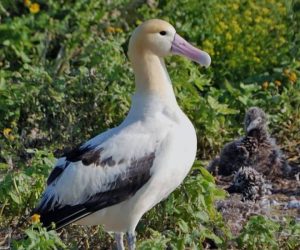By Mutalib Jibril

The albatross is a large seabird and part of the Diomedeidae biological family. The bird is commonly found in the North Pacific and the Southern Ocean and can’t be seen in the North Atlantic. It is one of the world’s largest flying birds.
There are four main species of albatross: Great Albatrosses, North Pacific Albatrosses, Mollymawks and Sooty Albatrosses. These are divided into twenty-one species identified by the World Conservation Union (ICUN).
Great Albatrosses are among the largest flying birds, characterized by their impressive size. They are good in flight, with a significant portion of their lives spent airborne. Their diet consists of squid, fish, and krill. Albatrosses return to land to construct their nests, typically on islands and often in proximity to other bird nesting sites.
The Amazing Facts About Albatross Are:
1.The largest Wingspan of any living Bird
The wandering albatross, scientifically known as Diomedea exulans, boasts a remarkable wingspan of up to 12 feet, making it the largest living bird on Earth in terms of wingspan. This impressive wingspan enables the wandering albatross to glide effortlessly, covering distances of up to 500 miles in a single day, and maintaining speeds close to 80 mph for eight consecutive hours, all without the need to flap its wings.
2. Pelagic Lifestyle
These birds spend most of their lives at sea, only coming to land to breed and raise their chicks. They have specialized adaptations for life on the open ocean, such as salt glands to excrete excess salt from their bodies.
3.They Have the Longest Incubation Period of Any Bird
Albatross lay just one single egg every 2 years and that egg has the longest incubation period of any bird. The male and female take turns feeding and guarding their chicks until it is large enough to care for itself.
4. They Mate for Life
Albatrosses form lifelong bonds with their mates, a commitment they establish through a ritualized dance. Once they’ve selected their life partner, they remain together until death, as albatrosses are monogamous. This enduring partnership can last for 50 years or even longer.
5. They Can Smell food 20 Miles Away
Albatrosses have an astonishingly keen sense of smell that allows them to detect the scent of food in the water beneath them from remarkable distances, often reported to be up to 12 miles (about 19 kilometers) away. This remarkable sensory ability is a crucial tool for these birds as they search for prey while flying over the open ocean.
6.The Albatross Can Live More than 40 Years in the Wild
Albatrosses are known for their impressive longevity, and many individuals can live for more than 40 years in the wild. Some have even been recorded living for several decades longer, with the oldest known wild albatross living to be over 80 years old. These extended lifespans make albatrosses one of the longest-lived bird species on the planet.
7.Flying Techniques
Albatrosses are expert gliders and use dynamic soaring techniques to travel efficiently. They utilize wind gradients near the ocean’s surface and can soar for hours without flapping their wings.
8. They are at Risk of Extinction
Albatrosses are vulnerable to becoming unintentional bycatch in longline and trawl fisheries. They are attracted to baited hooks and can get hooked or tangled in fishing gear, leading to injury or death.
Plastic debris in the ocean also poses a significant threat to albatrosses. They can ingest plastic particles, mistaking them for food, which can lead to malnutrition, injury, or even death.
